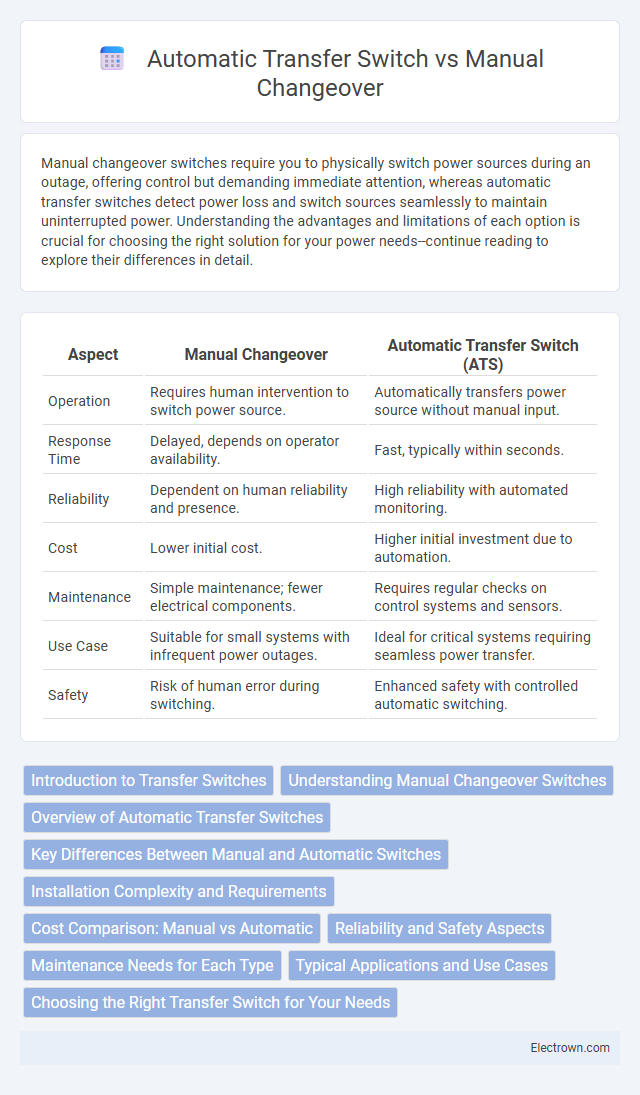Manual changeover switches require you to physically switch power sources during an outage, offering control but demanding immediate attention, whereas automatic transfer switches detect power loss and switch sources seamlessly to maintain uninterrupted power. Understanding the advantages and limitations of each option is crucial for choosing the right solution for your power needs--continue reading to explore their differences in detail.
Table of Comparison
| Aspect | Manual Changeover | Automatic Transfer Switch (ATS) |
|---|---|---|
| Operation | Requires human intervention to switch power source. | Automatically transfers power source without manual input. |
| Response Time | Delayed, depends on operator availability. | Fast, typically within seconds. |
| Reliability | Dependent on human reliability and presence. | High reliability with automated monitoring. |
| Cost | Lower initial cost. | Higher initial investment due to automation. |
| Maintenance | Simple maintenance; fewer electrical components. | Requires regular checks on control systems and sensors. |
| Use Case | Suitable for small systems with infrequent power outages. | Ideal for critical systems requiring seamless power transfer. |
| Safety | Risk of human error during switching. | Enhanced safety with controlled automatic switching. |
Introduction to Transfer Switches
Transfer switches are critical devices that manage the safe and efficient transfer of electrical power between primary and backup sources. Manual changeover switches require human intervention to switch power sources, offering simplicity and cost-effectiveness for smaller or less critical systems. Automatic transfer switches detect outages and seamlessly transfer power without user input, ensuring continuous operation in essential facilities like hospitals and data centers.
Understanding Manual Changeover Switches
Manual changeover switches require human intervention to disconnect the power source and switch to an alternative supply, ensuring control during power outages or maintenance. These switches are typically simple in design, reliable, and cost-effective for applications where automatic transfer is not critical. Understanding the operational limitations and safety protocols is essential for efficient use in residential, commercial, or industrial power systems.
Overview of Automatic Transfer Switches
Automatic Transfer Switches (ATS) are critical components in power management systems designed to seamlessly switch the power load from a primary source to a backup generator during outages. These devices continuously monitor utility power, ensuring an uninterrupted energy supply by automatically initiating the transfer within seconds of detecting power failure. Equipped with advanced sensors and control mechanisms, ATS enhance operational reliability and minimize downtime in commercial and industrial applications.
Key Differences Between Manual and Automatic Switches
Manual changeover switches require you to physically switch power sources during an outage, offering simplicity and lower cost but demanding constant human intervention. Automatic transfer switches (ATS) detect power failures and instantly switch to backup power, ensuring seamless operation with minimal downtime and enhanced safety. Understanding these key differences helps you choose between straightforward manual control and the reliability of automated power management.
Installation Complexity and Requirements
Manual changeover switches require a straightforward installation process with minimal wiring, making them suitable for simpler systems and cost-conscious setups. Automatic transfer switches demand more complex installation due to integrated sensors and control mechanisms that ensure seamless power source switching, often necessitating professional expertise. Proper sizing, compatibility with existing electrical panels, and adherence to local electrical codes are critical for both types to ensure safe and reliable operation.
Cost Comparison: Manual vs Automatic
Manual changeover switches generally have a lower initial cost, making them a budget-friendly choice for smaller applications or less critical power systems. Automatic transfer switches (ATS), while more expensive upfront, provide reliable, seamless power transfer that minimizes downtime and operational disruptions. Over time, the reduced risk of manual errors and improved system continuity often justify the higher investment in automatic transfer switches for commercial and industrial settings.
Reliability and Safety Aspects
Manual changeover switches require human intervention, which can introduce delays and increase the risk of error during power source transitions, affecting both reliability and safety. Automatic transfer switches (ATS) enhance reliability by instantly detecting power failure and seamlessly switching to a backup source without manual input, reducing downtime and minimizing electrical hazards. Your choice should consider that ATS systems provide superior safety features like built-in fault detection and automatic load balancing that protect equipment and personnel more effectively than manual systems.
Maintenance Needs for Each Type
Manual changeover switches require regular inspection to ensure proper mechanical operation and contact cleanliness, with maintenance often involving lubrication and tightening of connections to prevent failure. Automatic transfer switches demand more frequent testing of electrical components and control systems to guarantee seamless power transfer during outages, including routine verification of sensors, relays, and battery backup systems. Both types benefit from periodic preventative maintenance to extend service life, but automatic transfer switches generally incur higher maintenance complexity due to their integrated control circuitry.
Typical Applications and Use Cases
Manual Changeover switches are commonly used in residential or small commercial settings where power outages are infrequent and budget constraints favor simpler installation. Automatic Transfer Switches (ATS) are ideal for critical facilities such as hospitals, data centers, and industrial plants, ensuring seamless power transfer without interruption. You should select an ATS for mission-critical applications requiring immediate backup power or a manual switch for locations with low outage risk and easy access to controls.
Choosing the Right Transfer Switch for Your Needs
Selecting the right transfer switch depends on your power backup requirements and budget. Manual changeover switches offer cost-effective, straightforward operation but require you to physically switch power sources during outages, making them suitable for infrequent use or small setups. Automatic transfer switches provide seamless, real-time power transfer without intervention, ideal for critical systems where uninterrupted power is essential to protect your equipment and maintain operations.
Manual Changeover vs Automatic Transfer Switch Infographic

 electrown.com
electrown.com